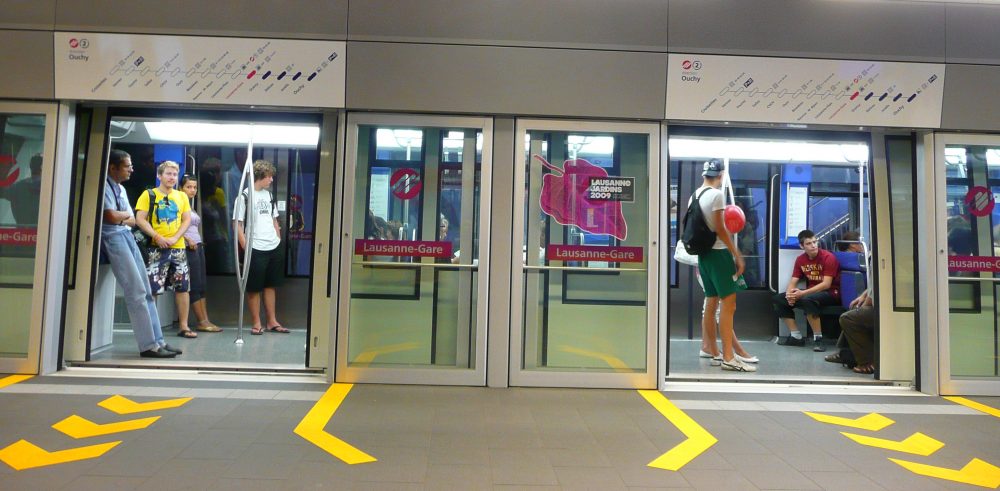- Abstract
Our paper investigates the role of language on shop signs in Chauderon, one of the sub-sectors of Lausanne, Switzerland. We found that language in shop signs had different roles, some were more used to attract customers through the trends surrounding their use, other target a specific ethnicity but don’t exclusively attract foreigners as they try to get to everyone. Some of the establishment we focused on even displayed a different language on their window than the one that is most used in the back stages or with the clientele.
- Introduction
The mapping of specific Linguistic landscapes has been theorized and analyzed in various cities and locations through different focal points whether it was shop signs, road signs, or even public spaces. Landry and Bourhis put the first accepted definition of linguistic landscape forth in 1997 in their paper it refers to “the visibility and salience of languages on public commercial signs in a given territory or region. It is proposed that the linguistic landscape may serve important informational and symbolic functions as a marker of the relative power and status of the linguistic communities inhabiting the territory”. Since then, many researchers modified certain aspects of the notion of Linguistic Landscape without changing its essence. For example, Lü Hefa defines the Linguistic Landscape through the information of the sign, whereas Landry and Bourhis focus on the language itself, or even, as most studies tend to focus on the construction of space in city centers, through the signs present, which some researchers refer to as “linguistic landscape” as “linguistic cityscape” as presented in Jingjing Wang (2013). In the case of this study, the focus is on shop signs, as these are mirrors of ethnic groups with their corresponding languages and specific targeted demographic. The “shop sign” is a well-documented study which, with much research focusing on either famous cities or even smaller ones for example the two texts following. In order to give context to this study, we used two texts for comparison, the first one is from Alexander Nikolau (2017) and the second text is from Jingjing Wang (2013). As we decided to focus on shop signs specifically, context was an important point, therefore presenting two approaches to linguistic landscapes, one in Europe and the other in Asia, seemed appropriate.
The aim of this research is to examine the role of the languages appearing on various shop signs in Chauderon. We will analyze these signs as informational tools for potential customers. In our contextualization section, we provide information on Chauderon, its history and its demography. In the Methodology section we explain that we gathered pictures of the various shop sings on windows we found with our smartphones, where languages other than French were present. As we collected this data, we decided to separate it in various categories such as man and secondary languages, as well as top-down or bottom-up. The point of this study is to find a link between various shops signs and ethnic businesses, as well as emphasize the information provided by these various shop signs to the customer. Therefore, in our result section, we present this data sorted through our categories and draw the conclusions such as: English is used in order to attract the client rather than telling that English is a spoken language of the shop, or even that the shop present the use of an alphabet which does not match the language spoken.
- Theoretical framework
For this study, we decided to base our research on three different studies, two of which are strictly studies of Linguistic Landscape of cities such as Athens and Beijing while the other text served as our basis for definitions and theories about the concept of “linguistic landscape”. We focused more on the former texts, as they more closely resembled our study. The study of Landry and Bourhis in 1997, treated the topic in a more general way, since it established the basis of “linguistic landscape studies”, while not being the first one to study signs. A linguistic landscape “refers to the visibility and salience of languages on public commercial signs in a given territory or region. It is proposed that the linguistic landscape may serve important informational and symbolic functions as a marker of the relative power and status of the linguistic communities inhabiting the territory”. This definition served as our basis for our study; however, the second part concerning the “informational and symbolic functions” seemed even more important as our study revolve around these notions. The symbolic elements and the informational elements of these signs served various purpose further discussed in our results and discussion sections.
The article by Jingjing Wang (2013), is a study on shop signs on Wangfujing Street in the city of Beijing, focused on the occurrence of various languages such as English, Japanese, French or even Arabic, in order to find a link between China’s language policies and the results. The results were analyzed with unilingual and bilingual occurrences as factors. In our analysis, we further divided these two factors in sub categories such as main language, secondary, as well as their potential symbolic value. In the case of Beijing, Wang assumed that as Wangfujing Street is in center of Beijing, it was more subject to trends, and fast development, which would result in a rapid and substantial presence of foreign languages as foreigners traveled temporarily to China or with intent to stay there, therefore being the ones for whom trends were so important. The results out of 89 samples, coincided with the assumption that English is a dominant foreign language as 45 % of the signs contained English in them whereas only 27% were Chinese only. These numbers are the results of the People’s Republic policies: The standardization of Chinese, the propagation of English and the development of minority languages (Wang, J. 2013). This text allowed us to contextualize Chinese development of multilingualism through shop signs and give us reference for more precise research such as Landry and Bourhis (1997).
However, the text, which served as comparison to our study is the one by Alexander Nikolau[1]. In his research, Nikolau mentions the difference between indexical and symbolic choice of language for shop signs (as cited in Nikolau, 2017). A foreign language might be used as a way to indicate the owner’s ethnicity thus attracting people from that same ethnicity or language, in that case, the language is indexical. Whereas symbolic choice aims to represent something all people associate with that language, this is often the case for restaurants serving Italian food or places using the English language for its common association with modernity. Very often Italian restaurants are not actually owned by Italian people, the language only serves as an indicator for the type of cuisine that is served there. English is associated with modernity perhaps for historical reasons having to do with USA’s industrialization during the 1950s and even today with enterprises like Apple or Microsoft being established there.
- Contextualization
The districts of the city of Lausanne are separated into subsectors. Lausanne’s Centre is the third most populated district with 12’770 inhabitants representing around 8.9% of the population of the city. This district is separated in 10 different sub-sectors. Our study focuses on Chauderon, one of these sub-sectors, located at the northwestern end of the neighborhood (see Fig.1). We chose this area because one of us lives there and noticed several shops displaying foreign languages. According to the Office d’appui économique et statistique, Chauderon is at the same time the second most populated as well as the second denser sub-sector of Lausanne Center. In addition to this, it is also the sub-sector of the district that displays the largest number of inhabitants of foreign origin. These numbers amounted to 1131 in December 2017, which represents 51.8% of the population in the neighborhood. These statistics are even more interesting considering that the average of the district is 45.6% and that of the city is found to be 43%.
Chauderon has three main functions, accommodation, the presence of mainly tertiary sector employment, and to a lesser extent secondary sector employment, as well as mobility. In Chauderon’s history it is evident that what distinguishes this place in the city of Lausanne is that it has been and still is to this day a mobility center. The Chauderon station built in 1873 still exists today, although in the meantime it has become an underground one. Its bridge built in 1905 and the piercing of the Avenue de Beaulieu in 1912 transformed Chauderon in a public transport hub already at the time. In the same year, the drilling of the Chauderon road tunnel was completed. In 1977 a bus shelter was built and has been transformed in 1998 to give birth to the one that exists today. Moreover, today we have 3 times more buses stopping in Chauderon than in Lausanne station (see Fig.2).
- Methodology
In order to collect the necessary data regarding the linguistic landscape in Chauderon, we took several pictures of shop signs, windows and other signs such as graffiti. We paid special attention to shop windows where other languages besides French were on display. Concerning the cameras used to photograph the signs, we simply used the ones on our smartphones. We were very optimistic with the amount of ethnic businesses in just this neighborhood, we soon realized though that some of these are known to be ethnic business not by the writing on their windows – that sometimes is only in the French language – but by the tongue spoken inside among the costumers and the workers.
Once we gathered the pictures we needed, we classified them on a table (table 1) and established some categories of analysis, which would allow us to understand the purpose the languages were used on the different windows. While doing this we decided to focus exclusively on shops instead of taking into consideration every mark of multilingualism we could find.
The main goal of this research is to understand the use of foreign idioms as informational tools for the people who pass by, therefore, we chose a set of appropriate categories in order to classify and compare the signs. These categories are: “Type of sign”, “Main language”, “Secondary language(s)”, Indexical or Symbolic for both main and secondary languages, “Monologic/ Dialogic” and finally “Top-down/Bottom-up”.
- Results
As shown in Table 1 French is very often displayed on the signs, either as main or secondary language, as it is Lausanne’s official language. The only exception to this is Mighty Games, which implies that the clientele knows that the name is not an indicator of the language that is spoken inside the store, as English is often associated with board games.
Concerning the appearance of English, although it appears as the main language in five different shops, only Books Books Books is owned by actual English-speaking people and sells products for English speaking people specifically. Businesses such as Mighty Games, McDonald’s and Scope use English purely symbolically, meaning this language has the cultural value of often being associated to gaming, fast-food and music. Nevertheless, other places using a foreign language as the main one for their signs, for instance Pena Hispanica (the ~ is not omited here maybe because it does not exist in French) and Doushka are actually owned respectively by a Spanish and Russian person. Aside from English, Italian is the only other language that appears as symbolic, in La Nonna’s menu, that has a French translation for every plate and as explained previously, Italian is more often associated with cuisine than with the people who own the restaurant.
According to table 1, French often appears in a Top-down position, which again is due to the fact that it is Lausanne’s official language. Nevertheless, this is not the case in Milano’s Pizza shop window, where it appears as less important than English. French also appears as less important that Arabic in El Baraka’s shop window, meaning that the costumers are probably Arabic speakers themselves. Aside from this, in most cases, foreign languages are Bottom-up.
We can also notice that in the cases of Chez Manu and Mighty Games, the secondary languages are only perceivable by hear, instead of written signs, which could be argued as not being part of the linguistic landscape.
| Shop | Main language | Secondary | Main language
Indexical/symbolic |
Secondary language(s)
Indexical/Symbolic |
Top-down/Bottom-up |
| Books books books (fig.3) | English | French | Indexical | – | Bottom-up |
| Chez Manu (fig.4) | French | Portuguese (Soundscape) | – | – | Top-down |
| Doushka (fig.5) | Russian | French | Indexical | – | Bottom-up |
| El Baraka (fig.6) | French | Arabic | – | Indexical | Bottom-up |
| La Mise en Bière (fig.7) | French | English | – | Symbolic | Top-down |
| La Nonna (fig.8) | French | Italian | – | Symbolic | Top-down |
| Mighty Games (fig. 9) | English | French (Soundscape) | Symbolic | – | Top-down |
| Milano’s Pizza (fig.10) | English &
French |
– |
Symbolic (English) | – | Top-down/Bottom-up |
| McDonald’s (fig. 11) | English | French | Symbolic | – | Bottom-up |
| Pena Hispanica (fig. 12) | Spanish | French | Indexical | – | Bottom-up |
| Score (fig. 13) | English | French | Symbolic | – | Bottom-up |
Table 1
- Discussion
The data from table 1 shows us that French is present in the Linguistic Landscape regardless of it being the main or second language. This information means that none of the businesses, even the ethnic ones such as El Baraka or Pena Hispanica aim to exclusively attract foreign clients, or clients who speak the languages displayed. However, Books Books Books’ window (fig. 3) has a French written sign about the parking spots in front of the shop. This sign does not have the goal of attracting French-speaking clients. In this case, French is used in order to accommodate people passing by, so they can understand.
Although English appears in six out of the eleven signs, it only appears as indexical of actual English-speaking owners once, meaning it is mostly used as a trend. Moreover, in the case of Mighty Games (fig.9), despite the fact that it is the sign’s main languages, the workers and clients never communicate in English. This choice of language might be because English is often linked with the universe of games.
English also appears as purely symbolic in the cases of Score and McDonald’s because English is not actually spoken inside of any of these places and their owners are French-speakers. However, Mcdonald’s is indeed an American Fast Food chain. In this case, McDonald’s is attracting clients simply because it is a well-known brand and not because it wants to follow a trend. This could also be argued for La Mise en Bièse (fig.7) were some of the beers displayed on the window featuring text in English are actually imported English or American beers, even though the shop has a name written in French.
Nonetheless, Spanish and Russian are chosen with the intention of attracting Spanish and Russian people, but also of giving an impression of authenticity to perhaps clients who are not Spanish nor Russian. By naming themselves in a foreign language in this situation, these businesses are not symbolizing something from popular culture, unlike the restaurant La Nonna that is an Italian food restaurant therefore the menu is in both French and Italian. However clients only assume that this places serves a certain kind of food and not necessarily assume that the owners are Italian.
Doushka is not written in Cyrillic script, which makes it readable for non-Russian speakers. Although they cannot know the meaning of this word, they can also read the information in French underneath (fig. 5). The translation of Russian into French shows that French speakers not only are welcome but that they will also be able to communicate in French inside.
Finally, in both Mighty Games and Chez Manu (fig.4), the languages displayed are not the languages mainly spoken. For instance, most of the clients and all working staff at Chez Manu are Portuguese. Nevertheless, the blackboard outside is fully written in French and it is impossible to guess that it is a Portuguese Bakery from its name. This demonstrates that there are, in fact, some limits to the conventional definition of the Linguistic Landscape, which could be barriers to the understanding of the different uses of language in Chauderon.
- Conclusion
In conclusion, we can say that English and Italian is generally more used as a way to attract clients than as sign of an English-speaking or Italian-speaking shop. Whereas Spanish, Russian and Arabic is more attractive to people that, share those same origins or languages. Even though they target a more specific clientele, they do not seclude themselves. Evidence to this is that they mainly use Latin script on their store window and not Cyrillic or Arabic.
This study can be more representative of the neighborhood if we address its limitations. The first limitation we can see is that we focused only on 11 different establishments, which in the end does not embody the entirety of Chauderon. In addition, defining a linguistic landscape can be hard if we only look at shop signs. It does not help us know which of the languages is the one that is the most relevant to it’s given landscape. This can be seen in two of our examples were clients and owners don’t speak the main language that is displayed on their front door. Another drawback we encountered was the fact that we tried to get as much information as possible, but our study depends on data that people were willing to give us. We noticed that some of the shops were not quite honest with us about the language they speak backstage and with the clientele. Leading to a point where we felt that we could not trust the information that was given to us. This problem could be addressed by observing and by gaining the trust of the people working there, through ethnographic fieldwork. Another limitation of our paper resides in the fact that backstage information was lacking in some establishments for example the owner’s nationality, origin and main language(s). As a future direction, we could extend our study to look at the role of multilingualism in multi-national and national chains present in the neighborhood and contrast it more strongly with the ethnic businesses as we noticed with McDonald’s and the fact that its American name has value simply as a brand and not a trend.
References
- Landry, R. & Bourhis, R (1997), “Linguistic Landscape and Ethnolinguistic Vitality, An Empirical Study”, Journal of Language and Social Psychology 16(1):23-49.
- Wang, J. (2013), “Linguistic Landscape of China: A Case Study of Shop Signs in Beijing”, Studies in Literature and Language, 6, No. 1, 2013, pp. 40-47
- Nikolau, A. (2017) , “Mapping the linguistic landscape of Athens: the case of shop signs”, International Journal of Multilingualism, 14:2, 160-182, DOI:, p.24
- Scollon, R., & Scollon, S. W. (2003). Discourses in place: Language in the material world. London: Routledge.
Websites:
Official statistics of the districts of the city of Lausanne. Available on : https://www.lausanne.ch/officiel/statistique/quartiers/tableaux-donnees.html. Accessed 27 December 2018
Official statistics of the districts of the city of Lausanne. Available on : https://www.lausanne.ch/officiel/statistique/quartiers/presentation-des-quartiers/01-centre.html. Accessed 27 December 2018
Tunnel de Chauderon. Created by RTS, 27.04.1964. Available on : https://www.notrehistoire.ch/medias/105. Accessed 27 December 2018
Bazzanella, Sylvie. “Place et pont Chauderon ”. Available on : https://www.notrehistoire.ch/medias/46200. Accessed 27 December 2018
Appendix
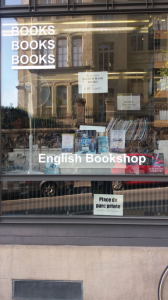
Figure 3 Books Books Books
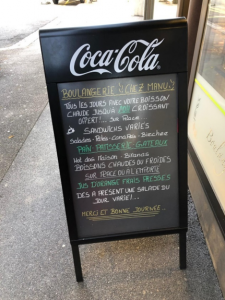
Figure 4 Chez Manu
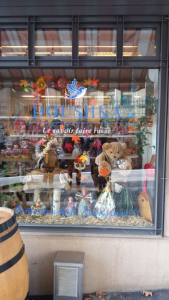
Figure 5 Doushka
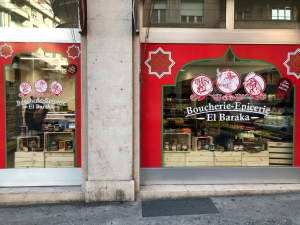
Figure 6 El Baraka
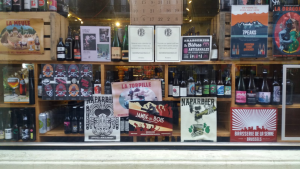
Figure 7 La Mise en Bière
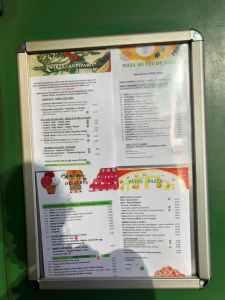
Figure 8 La Nonna
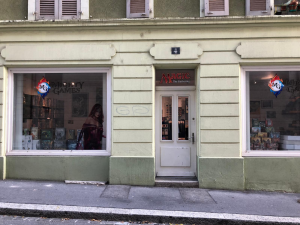
Figure 9 Mighty Games
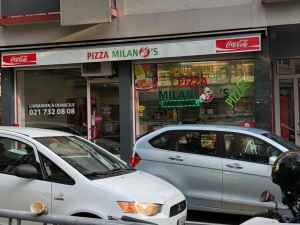
Figure 10 Milano’s Pizza
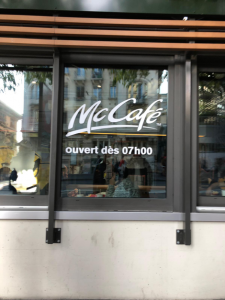
Figure 11 McCafé
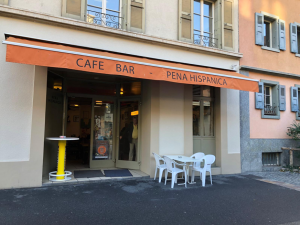
Figure 12 Pena Hispanica
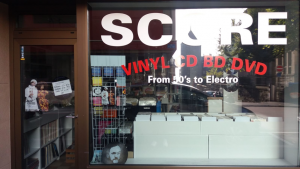
Figure 13 Score
